Review - Hanwei Scottish Court Sword
Dec 22, 2008 1:11:02 GMT
Post by Deleted on Dec 22, 2008 1:11:02 GMT
Hanwei Court Sword
Charles A. Appel – Marietta, Georgia, USA
INTRODUCTION
As I think I’ve said before, my area of interest centers on lightweight swords. Specifically I am interest in short swords and smallswords. Back in early march I did a pictorial on the first two smallswords in my modest collection. One was the Cold Steel Smallsword, which I reviewed here and the second was the Hanwei Court Sword.
At the time I purchased this sword I did so because it was one of the few reasonably priced smallswords on the market. That is not much of a recommendation but it is factual. I simply wanted a companion piece to the Cold Steel Smallsword.
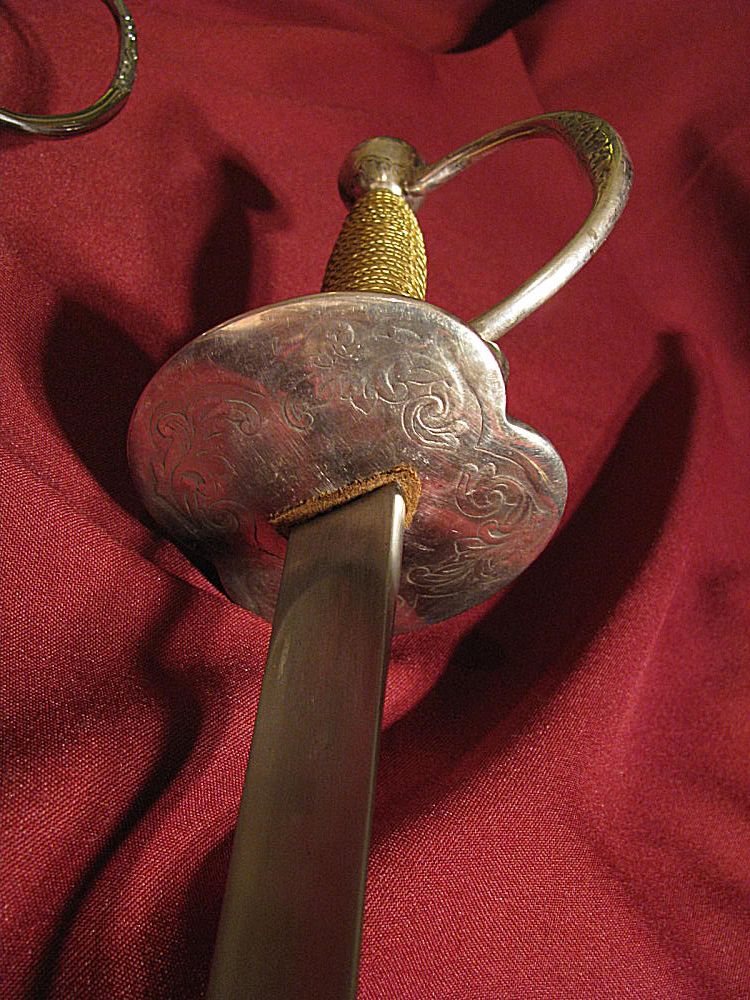
INITIAL IMPRESSIONS
When the sword arrived I viewed it with mixed feelings. The grip was comfortable and fit my hand better than did the one from Cold Steel. On the other hand, this is a very heavy for a smallsword. I must note that Hanwei does not market this as a smallsword. But as far as I can tell a court sword is just a fancy smallsword. Perhaps Scottish Court Swords were radically heavier than their English and French counterparts – but I have my doubts.

As to aesthetics, the sword initially left me cold. The engravings on the guard, pommel and knuckle guard were shallow and worn looking. I was not impressed. As you will see later, my opinion on this has changed.
Statistics:

(1) – Measured at the guard.
(2) – Measure three inches from end of blade.
DESIGN, FIT & FINISH
The Blade
The cross section of the blade of the Court Sword is a flattened triangle. It is very similar to the blade on the Cold Steel Smallsword. It is dull on all three of its edges except at the very tip. This is a thrusting weapon pure and simple. Like the Cold Steel product, the finish is not mirror bright.
This is the thickest blade I have encountered so far. It measures over four tenths of an inch thick at the guard. As you will see in a later section, the tang is also quite robust. Anything that can be made can be broken – but breaking this blade would be difficult.
The following information comes from Hanwei:
BLADE STEEL DESIGNATION: 65Mn
U.S. EQUIVALENT: 1566
% CARBON; 0.62-0.7
QUENCHING: OIL
EDGE OF BLADE: 48-52 HRC
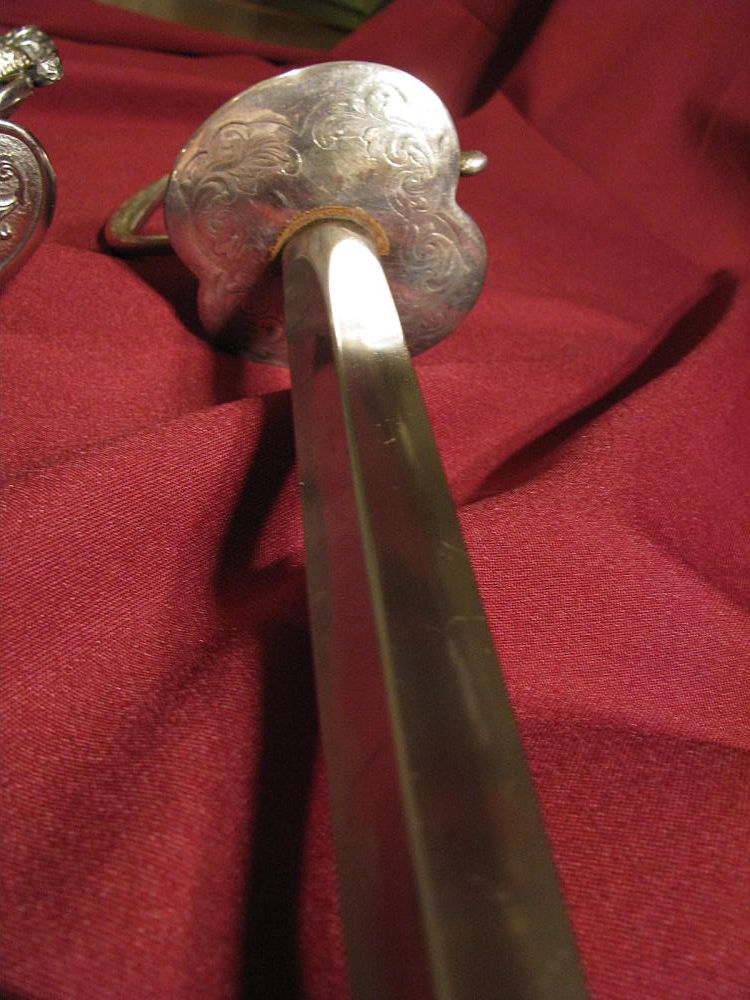
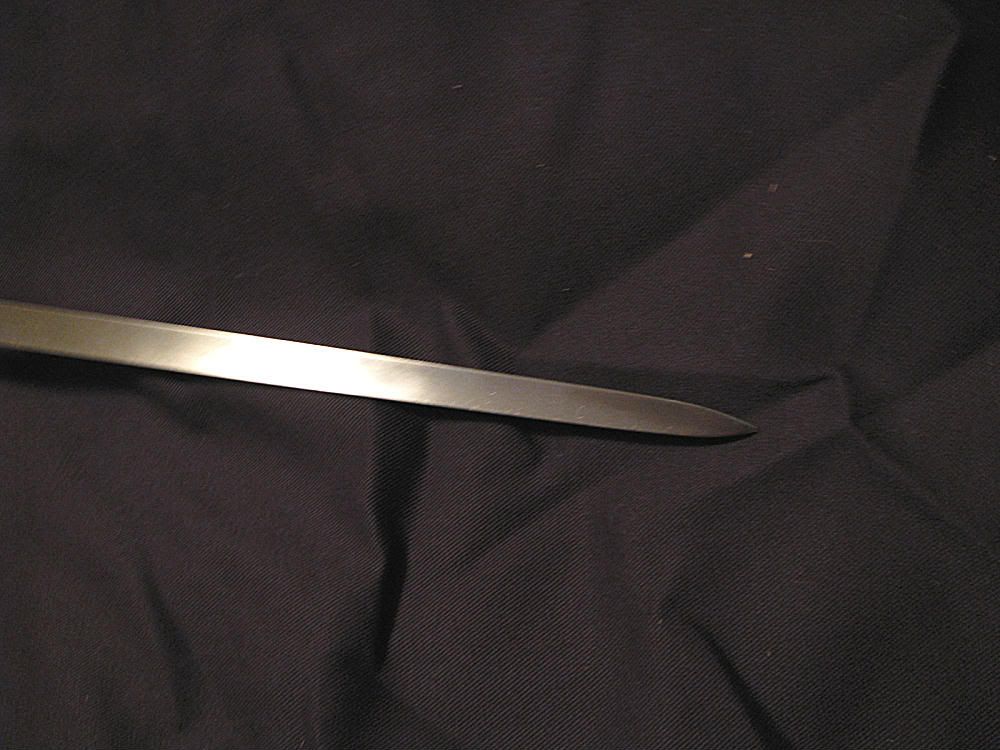
The Pommel
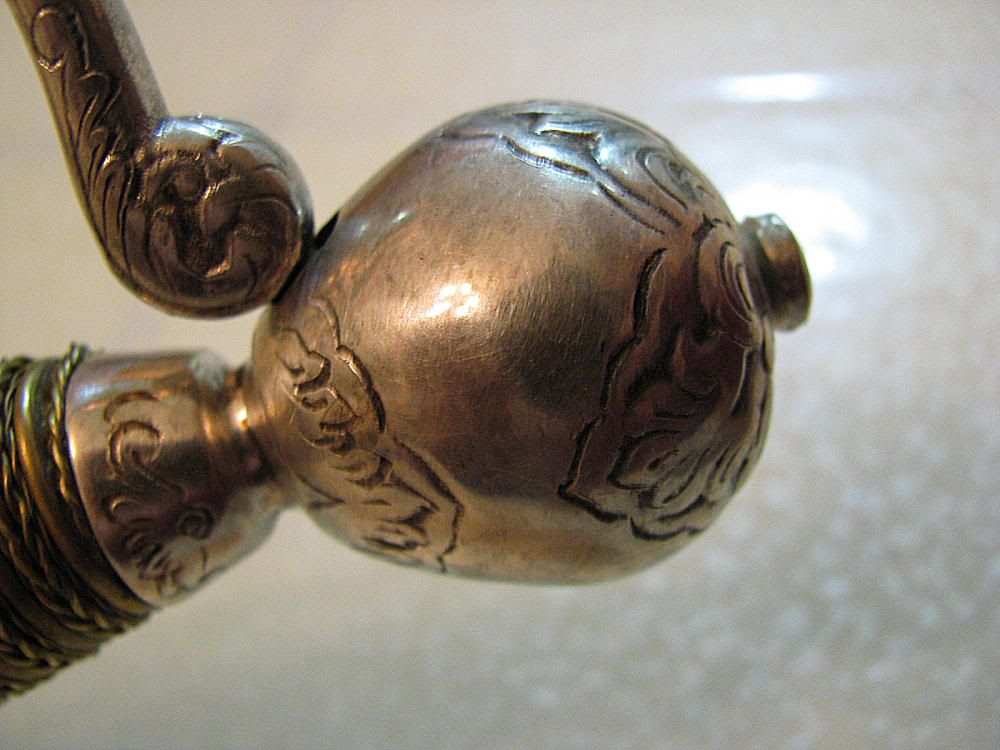
The pommel is made of a steel alloy and my guess is that it is cast. It is covered with worn looking floral engravings. In fact the entire hilt, except for the handle, follows this style. Initially this didn’t please me, but recently I have changed my perspective. Many original swords were passed from owner to owner and as they aged (and fashions changed) various parts might be replaced. An old blade might be placed in a new hilt for example. In this case, the sword looks, like one in which a new blade has been placed in a well worn hilt. I rather like this idea.
The Quillion Block
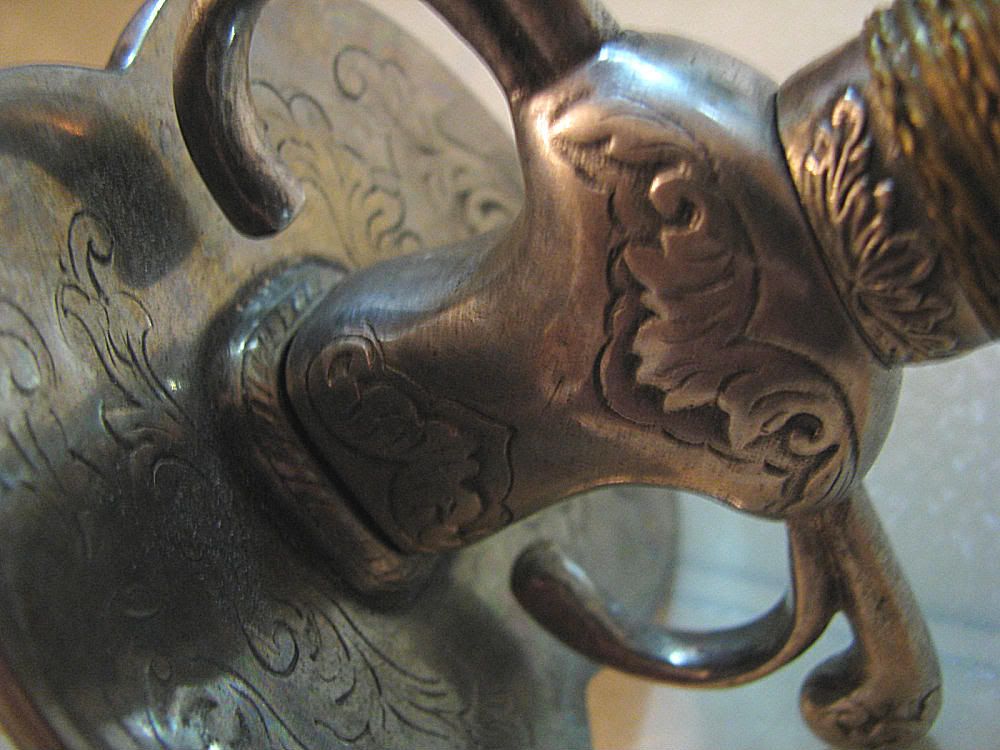
The steel quillion block follows the same pattern as the pommel. It is thick and heavy and helps with a comfortable grip. On the down side, the arms of the hilt could stand to have a bit more spread. Some of my gloves are just too thick to allow my fingers to enter the openings easily.
The Handle
The handle is plastic, wrapped in a combination of straight and braided wire. This plastic is quite thin and fragile in appearance. The front of the handle is covered with a steel cap with a floral motif. The rear of the handle fits into a hollow in the pommel.
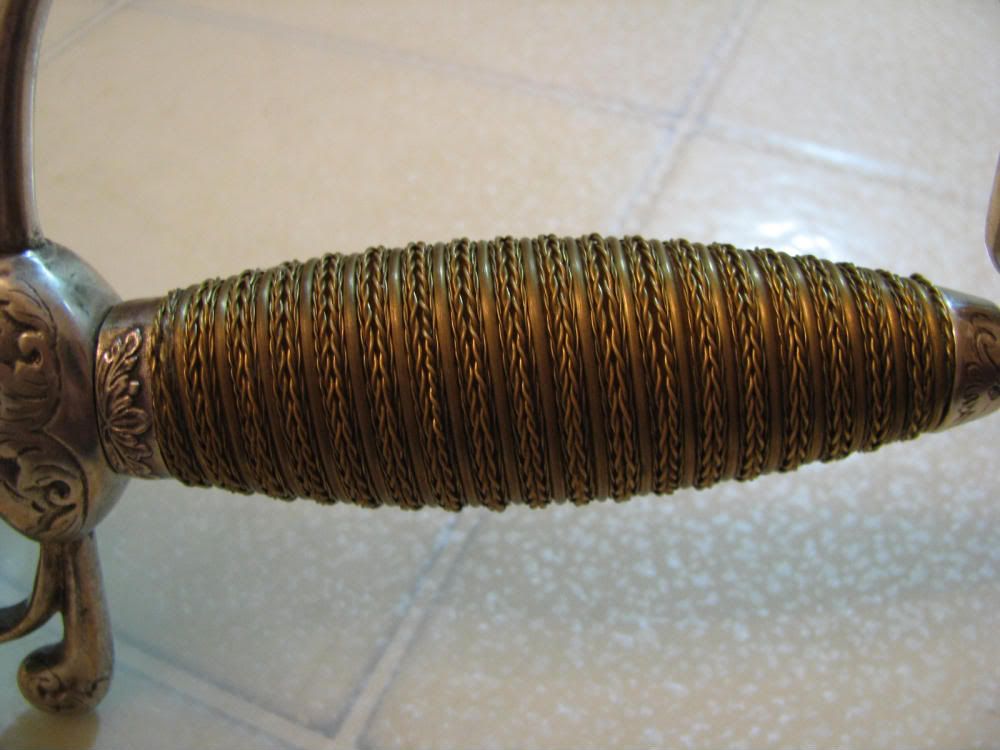
Above is a picture of the handle as it is today. Below is a picture of the handle when new. As you can see, the wire wrap has darkened a bit.
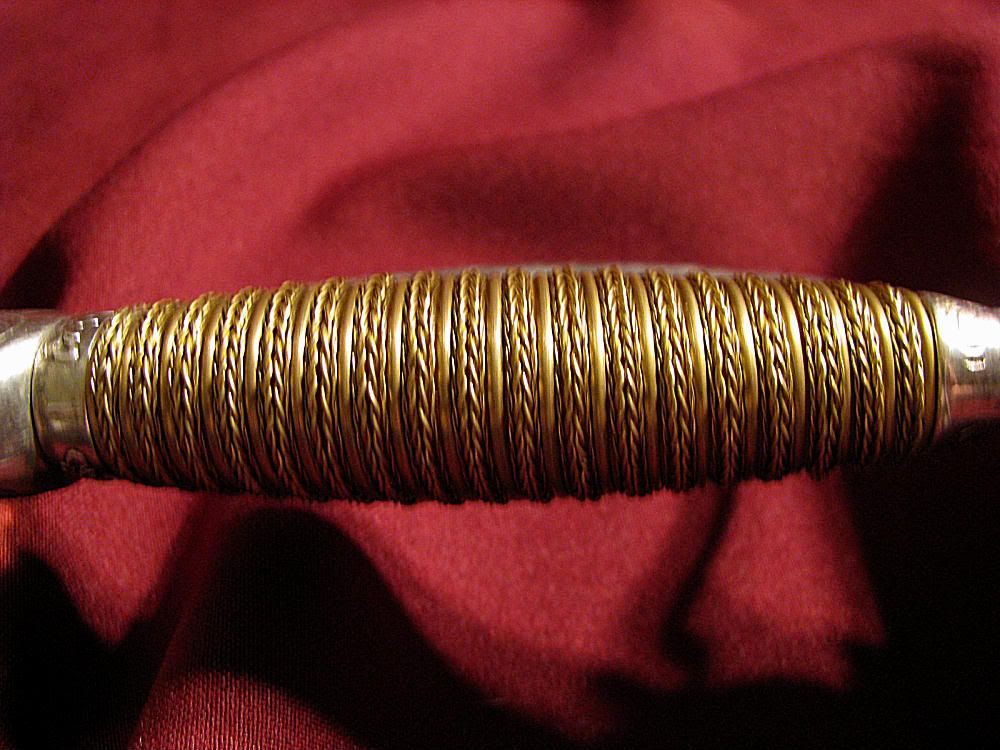
The Guard
The steel guard follows the same pattern as the pommel and quillion block. It consists of mirrored shells with a worn appearance, similar to what one might expect on an old silver-hilted or silver plated sword.
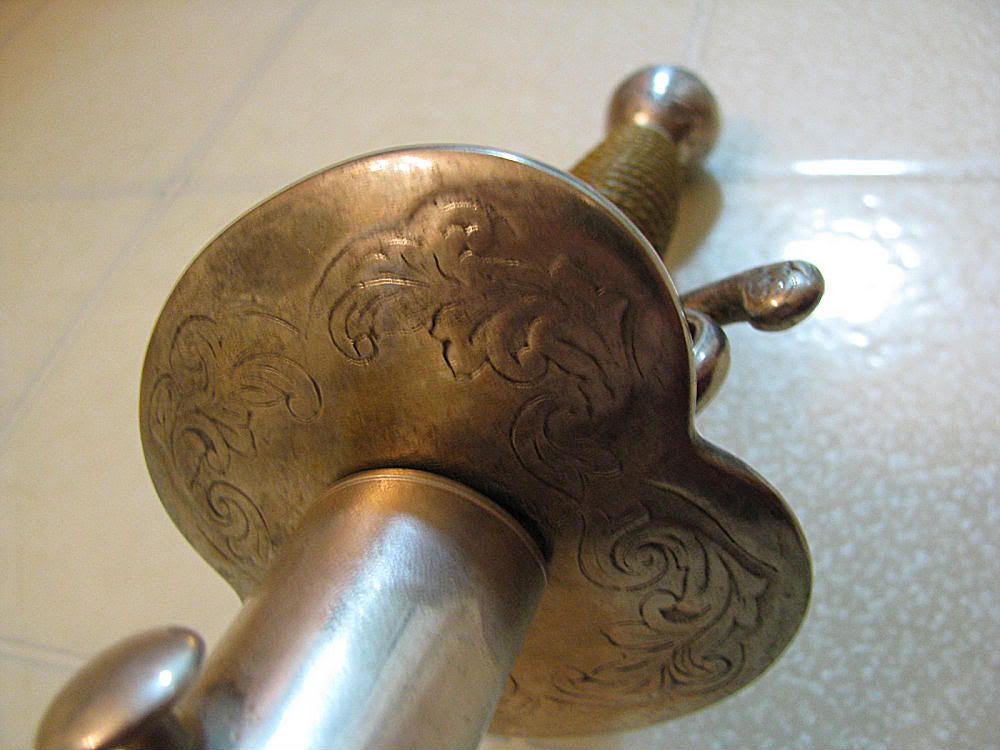
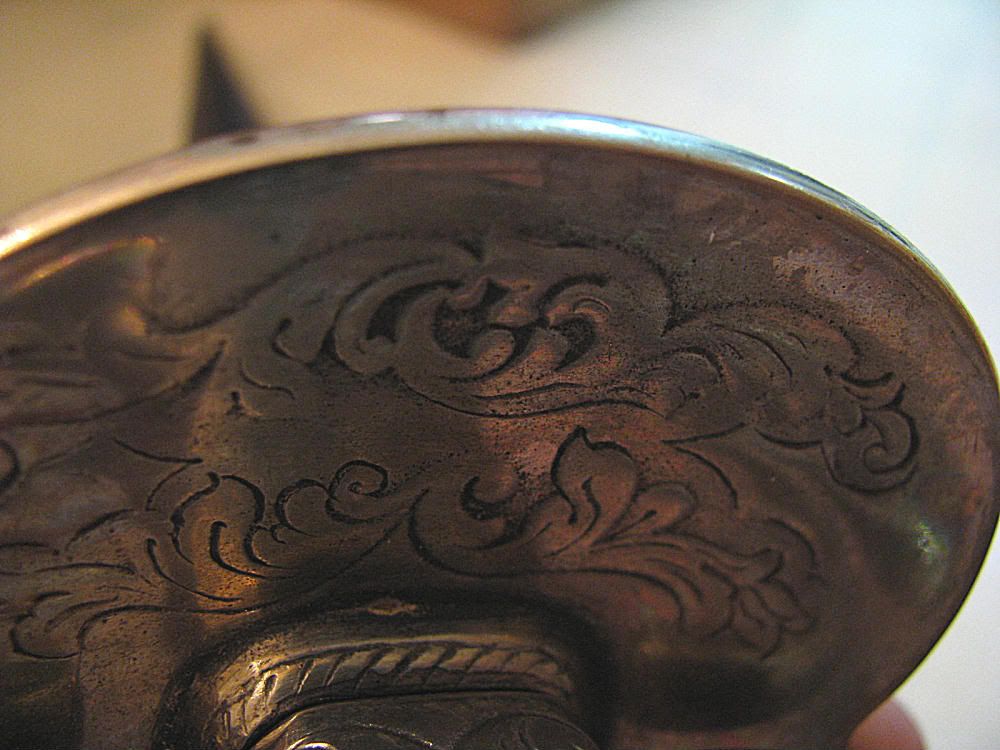
The Scabbard
The scabbard is constructed of wood covered in thin black leather. The throat is equipped with a frog stud and both throat and tip are steel. Both fittings are also quite plain and unadorned.


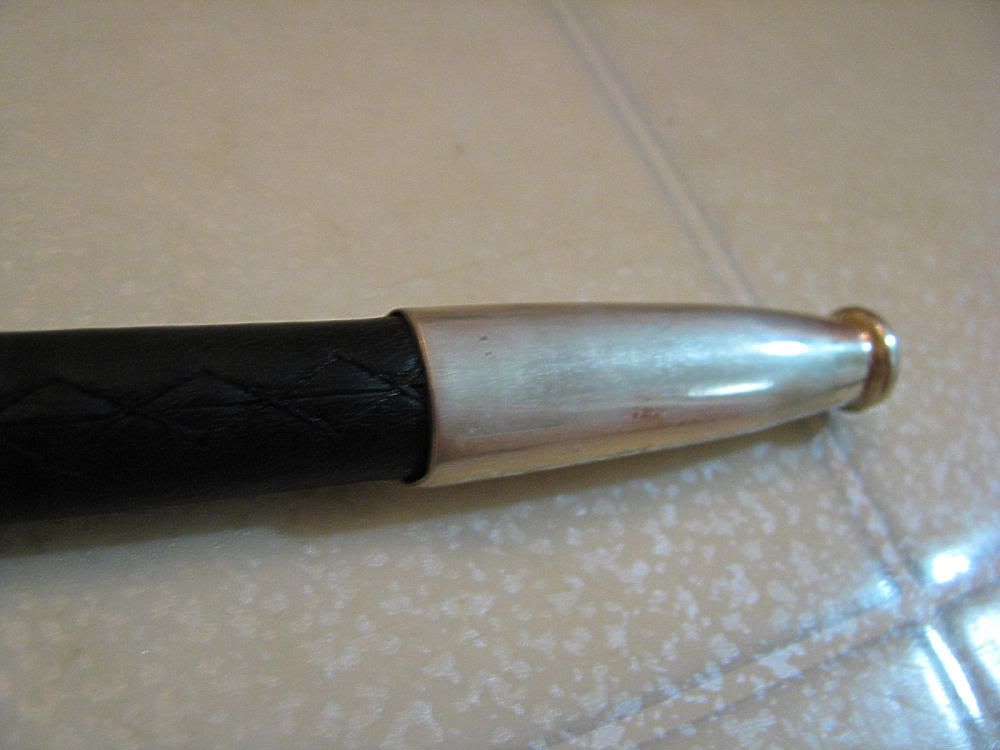
DISSASSEMBLY - REASSEMBLY
The hilt is readily removed from the sword and separated into its component parts. To do so, unscrew the pommel nut and set it aside. The rest of the hilt can then be slipped off the tang. It is composed of five parts as in the picture below.
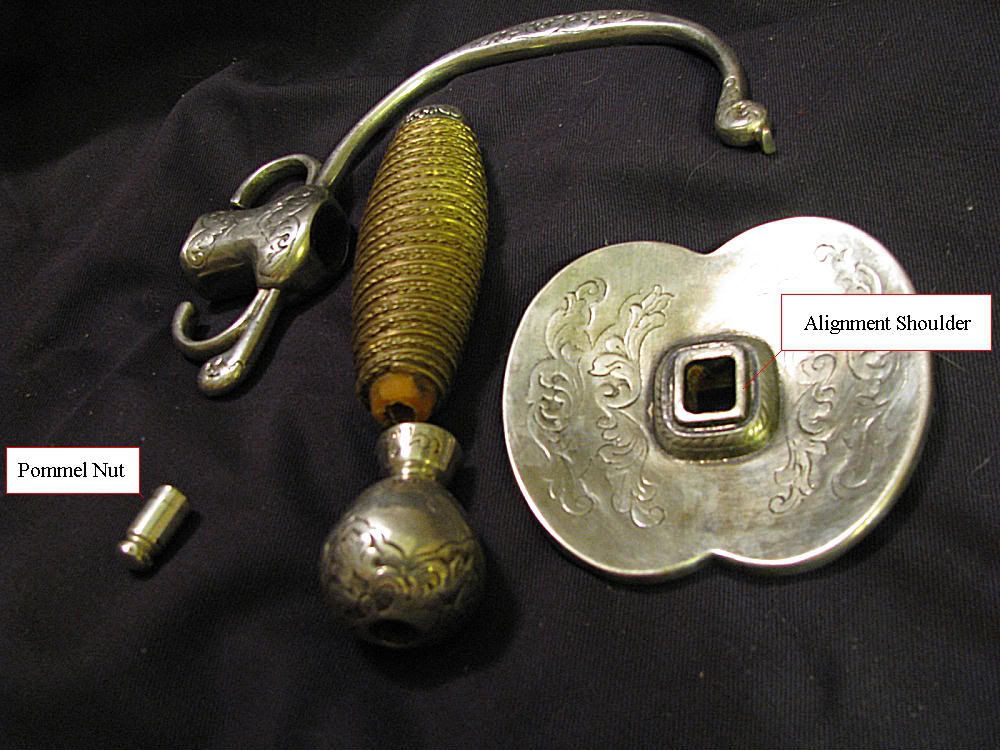
Below are pictures of the tang shoulders taken from both sides. The tang appears quite sturdy to me. But I am no expert. Perhaps some sword makers would care to comment.
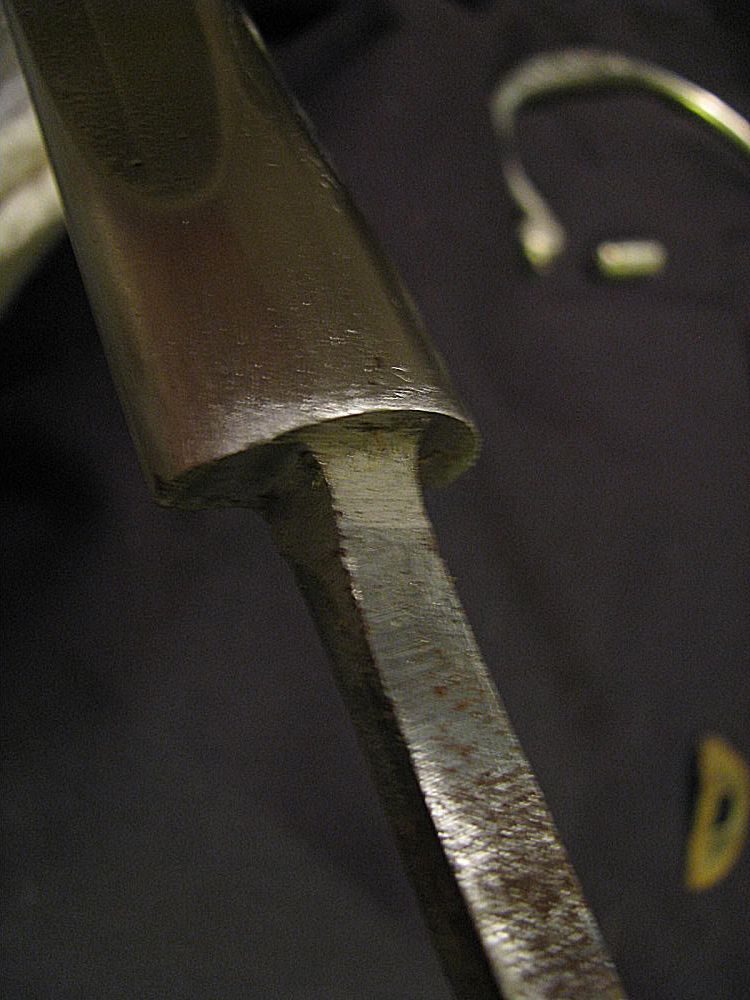

As is normal in the real world, reassembling the sword is a bit trickier than taking it apart. The quillion block must be placed over the alignment shoulder on the guard and held in place while the pommel nut is installed and tightened. I recommend removing the sword from the scabbard before performing this operation. In the photo below, I have deliberately misaligned the two. In many original smallswords this alignment shoulder is a separate washer.
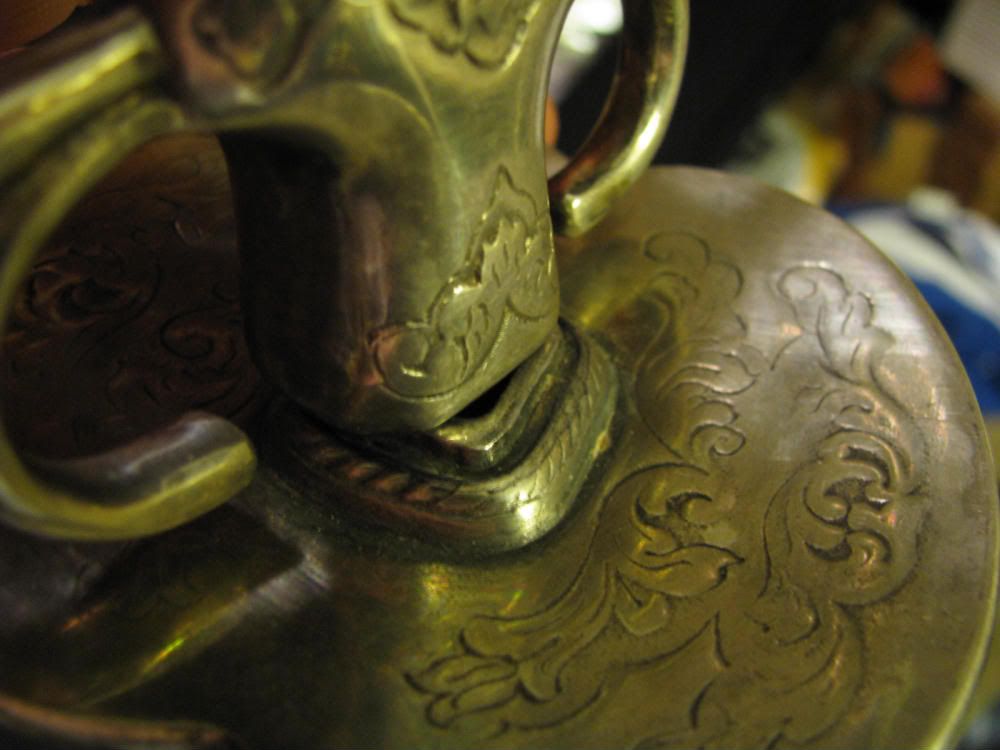
TESTING
Thrusting tests were conducted using cardboard boxes, water-filled containers, the remains of a hard plastic bucket and 5/16th inch plywood.

SLIDE Show
Handling
This sword handles about as well as the Taza Cup Hilt Rapier by the same maker. That is it handles well for a rapier. Unfortunately it is a smallsword or court sword. Were it eight ounces to a pound lighter, I think it would handle well. As it is, the extra weight makes it slow on parries and on recovering from a lunge. Hanwei calls the sword “quick and elegant”. Elegant it may be. Quick it is not.
Historical Accuracy
Hanwei claims that this sword was copied from an original carried by one of Bonnie Prince Charlie’s officers. I can neither confirm nor deny this. I have not been able to find a picture of that sword nor have I been able to find any technical information regarding it.
The Mad Piper website adds the information that this officer was Alexander Irvine the 17th Laird of Drum. Unfortunately I was only able to discover one portrait of this gentleman and in it he is not wearing a sword.
My primary problem with the accuracy of the sword is one of weight. The Hanwei sword weighs 32.2 ounces (0.941 kilograms). Typical court swords of this era tend to be much lighter. The average weight of seventy-two (72) swords(1), taken from the catalog at the swordlinks web site, was 17.298 ounces (490.396 kilograms). This places the Hanwei product at about twice the weight for a typical court sword or smallsword of the time.
(1) I chose the first seventy-three (73) swords, discarding one sword with the absurd weight of 47 grams (roughly 1.568 ounces). This weight is probably a typo.
For more information on Court Swords and Smallswords:
www.swordlinks.com/courtswords/courtswords.html
www.salvatorfabris.com/SectionSmallsword.shtml
www.hadesign.co.uk/SRS/html/thegraphic.htm
www.myarmoury.com/albums/thumbnails.php?album=55
CONCLUSION and SBG Ratings
If you want a good solid sword for reenactments or display or something strong enough to take on a sheet of plywood, this is it. It appears to be as sturdy as the Cold Steel Smallsword I reviewed earlier. On the other hand, if you want something that handles like an original smallsword, you should probably look elsewhere.
Historical Accuracy: Not sure.
Fit and Finish: 3/5
Handling: 3/5
Structural Integrity: 5/5
Value for Money: 4/5
OVERALL: 4/5
Charles A. Appel – Marietta, Georgia, USA
“Quick and elegant describe the Scottish Court Sword. Replicating an original dating from the 1730’s and belonging to an officer in Prince Charles Edward Stuart’s army at Culloden, the finely chiseled silver-plated hilt and three-edged hollow ground blade exemplify the consummate skill of the swordsmiths of the period.” - Description of the Hanwei Court Sword as it appears on the company web site.
“The finely chiseled hilt is silver plated nickel silver and is copied from the sword carried by Lord Alexander Irvine of Drum at Culloden 1746.” www.themadpiper.com/swords.htm
INTRODUCTION
As I think I’ve said before, my area of interest centers on lightweight swords. Specifically I am interest in short swords and smallswords. Back in early march I did a pictorial on the first two smallswords in my modest collection. One was the Cold Steel Smallsword, which I reviewed here and the second was the Hanwei Court Sword.
At the time I purchased this sword I did so because it was one of the few reasonably priced smallswords on the market. That is not much of a recommendation but it is factual. I simply wanted a companion piece to the Cold Steel Smallsword.

INITIAL IMPRESSIONS
When the sword arrived I viewed it with mixed feelings. The grip was comfortable and fit my hand better than did the one from Cold Steel. On the other hand, this is a very heavy for a smallsword. I must note that Hanwei does not market this as a smallsword. But as far as I can tell a court sword is just a fancy smallsword. Perhaps Scottish Court Swords were radically heavier than their English and French counterparts – but I have my doubts.

As to aesthetics, the sword initially left me cold. The engravings on the guard, pommel and knuckle guard were shallow and worn looking. I was not impressed. As you will see later, my opinion on this has changed.
Statistics:

| Blade Length: | 30.875 Inches | 78.423 cm |
| Handle Length: | 3.84 Inches | 9.74 cm |
| Hilt Length: | 7.125 Inches | 18.096 cm |
| Overall Length: | 38.0 Inches | 96.52 cm |
| Scabbard Length: | 32.25 Inches | 81.915 cm |
| Sword w/ Scabbard: | 39.5 Inches | 100.33 cm |
| Blade Width(1): | 0.944 Inches | 2.398 cm |
| Blade Thickness(1): | 0.415 Inches | 1.054 cm |
| Blade Width(2): | 0.355 Inches | 0.902 cm |
| Blade Thickness(2): | 0.218 Inches | 0.554 cm |
| Blade Thickness(3): | 0.204 Inches | 0.518 cm |
| POB: | 3.25 Inches | 8.255 cm |
| Sword Weight: | 33.2 Ounces | 0.941 kg |
| Scabbard Weight: | 5.8 Ounces | 0.164 kg |
| Total Weight: | 39.0 Ounces | 1.106 kg |
(1) – Measured at the guard.
(2) – Measure three inches from end of blade.
DESIGN, FIT & FINISH
The Blade
The cross section of the blade of the Court Sword is a flattened triangle. It is very similar to the blade on the Cold Steel Smallsword. It is dull on all three of its edges except at the very tip. This is a thrusting weapon pure and simple. Like the Cold Steel product, the finish is not mirror bright.
This is the thickest blade I have encountered so far. It measures over four tenths of an inch thick at the guard. As you will see in a later section, the tang is also quite robust. Anything that can be made can be broken – but breaking this blade would be difficult.
The following information comes from Hanwei:
BLADE STEEL DESIGNATION: 65Mn
U.S. EQUIVALENT: 1566
% CARBON; 0.62-0.7
QUENCHING: OIL
EDGE OF BLADE: 48-52 HRC


The Pommel

The pommel is made of a steel alloy and my guess is that it is cast. It is covered with worn looking floral engravings. In fact the entire hilt, except for the handle, follows this style. Initially this didn’t please me, but recently I have changed my perspective. Many original swords were passed from owner to owner and as they aged (and fashions changed) various parts might be replaced. An old blade might be placed in a new hilt for example. In this case, the sword looks, like one in which a new blade has been placed in a well worn hilt. I rather like this idea.
The Quillion Block

The steel quillion block follows the same pattern as the pommel. It is thick and heavy and helps with a comfortable grip. On the down side, the arms of the hilt could stand to have a bit more spread. Some of my gloves are just too thick to allow my fingers to enter the openings easily.
The Handle
The handle is plastic, wrapped in a combination of straight and braided wire. This plastic is quite thin and fragile in appearance. The front of the handle is covered with a steel cap with a floral motif. The rear of the handle fits into a hollow in the pommel.

Above is a picture of the handle as it is today. Below is a picture of the handle when new. As you can see, the wire wrap has darkened a bit.

The Guard
The steel guard follows the same pattern as the pommel and quillion block. It consists of mirrored shells with a worn appearance, similar to what one might expect on an old silver-hilted or silver plated sword.


The Scabbard
The scabbard is constructed of wood covered in thin black leather. The throat is equipped with a frog stud and both throat and tip are steel. Both fittings are also quite plain and unadorned.



DISSASSEMBLY - REASSEMBLY
The hilt is readily removed from the sword and separated into its component parts. To do so, unscrew the pommel nut and set it aside. The rest of the hilt can then be slipped off the tang. It is composed of five parts as in the picture below.

Below are pictures of the tang shoulders taken from both sides. The tang appears quite sturdy to me. But I am no expert. Perhaps some sword makers would care to comment.


As is normal in the real world, reassembling the sword is a bit trickier than taking it apart. The quillion block must be placed over the alignment shoulder on the guard and held in place while the pommel nut is installed and tightened. I recommend removing the sword from the scabbard before performing this operation. In the photo below, I have deliberately misaligned the two. In many original smallswords this alignment shoulder is a separate washer.

TESTING
Thrusting tests were conducted using cardboard boxes, water-filled containers, the remains of a hard plastic bucket and 5/16th inch plywood.

SLIDE Show
Handling
This sword handles about as well as the Taza Cup Hilt Rapier by the same maker. That is it handles well for a rapier. Unfortunately it is a smallsword or court sword. Were it eight ounces to a pound lighter, I think it would handle well. As it is, the extra weight makes it slow on parries and on recovering from a lunge. Hanwei calls the sword “quick and elegant”. Elegant it may be. Quick it is not.
Historical Accuracy
Hanwei claims that this sword was copied from an original carried by one of Bonnie Prince Charlie’s officers. I can neither confirm nor deny this. I have not been able to find a picture of that sword nor have I been able to find any technical information regarding it.
The Mad Piper website adds the information that this officer was Alexander Irvine the 17th Laird of Drum. Unfortunately I was only able to discover one portrait of this gentleman and in it he is not wearing a sword.
My primary problem with the accuracy of the sword is one of weight. The Hanwei sword weighs 32.2 ounces (0.941 kilograms). Typical court swords of this era tend to be much lighter. The average weight of seventy-two (72) swords(1), taken from the catalog at the swordlinks web site, was 17.298 ounces (490.396 kilograms). This places the Hanwei product at about twice the weight for a typical court sword or smallsword of the time.
(1) I chose the first seventy-three (73) swords, discarding one sword with the absurd weight of 47 grams (roughly 1.568 ounces). This weight is probably a typo.
For more information on Court Swords and Smallswords:
www.swordlinks.com/courtswords/courtswords.html
www.salvatorfabris.com/SectionSmallsword.shtml
www.hadesign.co.uk/SRS/html/thegraphic.htm
www.myarmoury.com/albums/thumbnails.php?album=55
CONCLUSION and SBG Ratings
If you want a good solid sword for reenactments or display or something strong enough to take on a sheet of plywood, this is it. It appears to be as sturdy as the Cold Steel Smallsword I reviewed earlier. On the other hand, if you want something that handles like an original smallsword, you should probably look elsewhere.
Historical Accuracy: Not sure.
Fit and Finish: 3/5
Handling: 3/5
Structural Integrity: 5/5
Value for Money: 4/5
OVERALL: 4/5








 . I agree with you about the 'worn' appearance, it rather appeals to me. but its such a shame about the weight. The only small-sword reproductions currently available here in Oz seem to be this and the Cold Steel one, and the CS model is much more expensive.
. I agree with you about the 'worn' appearance, it rather appeals to me. but its such a shame about the weight. The only small-sword reproductions currently available here in Oz seem to be this and the Cold Steel one, and the CS model is much more expensive.

